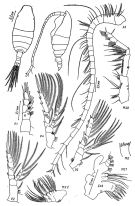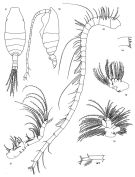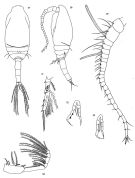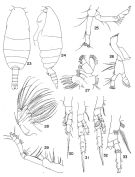|
|
 |
|
Calanoida ( Order ) |
|
|
|
Spinocalanoidea ( Superfamily ) |
|
|
|
Spinocalanidae ( Family ) |
|
|
|
Spinocalanus ( Genus ) |
|
|
| |
Spinocalanus longicornis Sars, 1900 (F,M) | |
| | | | | | | Syn.: | Spinocalanus schaudinni Mrazek,1902 (p.509, 521, figs.F,M); van Breemen,1908 a (part., p.29, fig.M); Sewell, 1948 (p.495);
no S. longicornis : Sars, 1901 a (1903) (p.22, figs.F); Jespersen, 1934 (p.51); 1940 (p.16);
S. abyssalis pygmaeus Farran, 1926 (part., p.243); Grice, 1962 a (p.101); Grice & Hulsemann, 1965 (p.223, 227); non Farran, 1929 (p.227); Vervoort, 1957 (p.41);
S. parabyssalis (F) Park, 1970 (part., p.483, figs.F, no M); Grice, 1971, figs.F: E-F); ? Björnberg, 1973 (p.322, 389);
? S. abyssalis : Farran, 1936 a (p.85) | | | | Ref.: | | | Sars, 1900 (part., p.75, figs.F, no M); 1903 (p.157, Rem.); Brodsky, 1950 (1967) (p.134, figs.F,M, Rem.); Vaupel-Klein, 1970 (p.4, 10, Rem.); Vidal, 1971 a (p.19, 24, figs.F,M); Damkaer, 1975 (p.20, figs.F,M, Rem.); Shih & Laubitz, 1978 (p.49); Gardner & Szabo, 1982 (p.196, figs.F,M); Brodsky & al., 1983 (p.255, figs.F,M); Schulz, 1989 (p.189: Rem.); Bradford-Grieve, 1994 (p.104, figs.F,M, fig.101); Vives & Shmeleva, 2007 (p.834, figs.F,M, Rem.) |  issued from : Brodsky K.A., Vyshkvartseva N.V., Kos M.S. & Markhaseva E.L. in Opred. Faune SSSR, 1983, 135. [p.254, Fig.116]. Female. A1 from Damkaer, 1975. Gnb = first lobe of Mx1.
|
 issued from : Brodsky K.A., Vyshkvartseva N.V., Kos M.S. & Markhaseva E.L. in Opred. Faune SSSR, 1983, 135. [p.255, Fig.117]. Male. A1 and ex P4 (exopodite of P4) from Damkaer, 1975.
|
 issued from : D.M. Damkaer in NOAA Technical Report NMFS CIRC-391, Seattle, 1975. [p.21, Fig.11-17; p.63, Fig.149]. Female: 11, habitus (dorsal); 12, idem (left lateral side); 13, A1; 14, masticatory edge of Md; 15, Mx1; 16, Mx2; 17, Mxp; 149, terminal segments of A1.
|
 issued from : D.M. Damkaer in NOAA Technical Report NMFS CIRC-391, Seattle, 1975. [p.22, Fig.18-26]. Female: 18, P1; 19, P2; 20, P3; 21, P4. Male: 22, A2; 23, 24, masticatory edge of Md (typically reduced, showing some slight variability); 25, gnathobase of Mx1; 26, Mx2.
|
 issued from : D.M. Damkaer in NOAA Technical Report NMFS CIRC-391, Seattle, 1975. [p.23, Fig.27-33]. Male: 27, habitus (dorsal); 28, idem (left lateral side); 29, A1; 30, Mxp; 31, exopodite of left P4; 32, P5; 33, P5 (different specimen);
|
 Issued from : T. S. Park in Bull. Mar. Sc., 1970, 20 (2). [p.484, Figs.23-33]. As Spinocalanus parabyssalis. Female: 23, habitus (dorsal); 24, idem (lateral left side); 25, A2; 26, Md; 27, Mx1; 28, Mx2; 29, Mxp; 30, P1 (anterior); 31, P2 (posterior); 32, P3 (posterior); 33, P4 (2nd and 3rd exopod segments broken off), posterior. Nota: Mx1 with 13 spines on 1st, 5 setae on 2nd, and 4 setae on 3rd inner lobe; 5 setae on basis; 4+5+7 setae on endopod. Mx2: base of 5th lobe usually bears scattered spinules. Mxp: basis without a comb of spines.
|
 issued from : G.D. Grice in Cah. Biol. Mar., 1971, XII. [p.278, Fig.3 E-F]. As Spinocalanus parabyssalis. With doubt. Female (from Medit.): E, habitus (lateral right side); F, Mxp (coxa and basis).
|
 Issued from : K.A. Brodskii in Calanoida of the Far Eastern Seas and Polar Basin of the USSR. Opred. Fauna SSSR, 1950, 35 (Israel Program for Scientific Translations, Jerusalem, 1967) [p.135, Fig.54]. Female (from Arctic): habitus (dorsal and lateral right side); Do, urosome (dorsal): S1, P1; S3, P3. Nota: Abdomen 1/3 length of cephalothorax. Ventral process of genital segment with overhanging lower part. A1 longer than body by 3-4 distal segments. Outer spines on exopodites of P1 not reaching base of following spines. No spines on posterior surface of P1. No spines on distal segments of exopodites of 3rd and 4th P4. Male: S5, P5. Nota: Head profile gratly protruding.
| | | | | Compl. Ref.: | | | Mrazek, 1902 (p.521); Vinogradov, 1968 (1970) (p.266); Buchanan & Sekerak, 1982 (p.41, Table 2: vertical distribution); Roe, 1984 (p.356); Scotto di Carlo & al., 1984 (1041); Sameoto, 1984 (p.213, Table 1); Sameoto & al., 1986 (p.53); Kosobokova, 1989 (p.27); Scotto di Carlo & al., 1991 (p.270) ; Mumm, 1993 (tab.1, fig.2); Sirenko & al., 1996 (p.349); Hure & Krsinic, 1998 (p.100, 112); Kosobokova & al., 1998 (tab.2); Razouls & al., 2000 (p.343, Appendix); Seridji & Hafferssas, 2000 (tab.1); Kosobokova & Hirche, 2000 (p.2029, tab.2); Auel & Hagen, 2002 (p.1013, tab.2, 3); Vukanic, 2003 (139, tab.1); Vukanic & Vukanic, 2004 (p.9, tab. 2); Hopcroft & al., 2005 (p.198, table 2); Blachowiak-Samolyk & al., 2007 (p.2716, Table 2); Blachowiak-Samolyk & al., 2008 (p.2210, Table 3, biomass); Schnack-Schiel & al., 2008 (p.1046: Tab.2); Darnis & al., 2008 (p.994, Table 1); Galbraith, 2009 (pers. comm.); Hafferssas & Seridji, 2010 (p.353, Table 2, 3: as longicormis); Kosobokova & Hopcroft, 2010 (p.96, Table 1, fig.7); Mazzocchi & Di Capua, 2010 (p.427); Dvoretsky & Dvoretsky, 2010 (p.991, Table 2); Hafferssas & al., 2010 (p.1281, Table III, abundance vs spatial distribution); Kosobokova & al., 2011 (p.29, Table 2, figs.4, 8, Rem.: Arctic Basins); Matsuno & al., 2012 (Table 2); Michels & al., 2012 (p.369, Table 1, occurrence frequency); Hirai & al., 2013 (p.1, Table I, molecular marker); Smoot & Hopcroft, 2016 (p.1, fig.3, 7, abundance vs water mass, vertical distribution) ; Benedetti & al., 2016 (p.159, Table I, fig.1, functional characters); Belmonte, 2018 (p.273, Table I: Italian zones) | | | | NZ: | 9 | | |
|
Distribution map of Spinocalanus longicornis by geographical zones
|
| | | | | | | | | | | | | Loc: | | | Antarct. (Peninsula, W Weddell Sea, SW Pacif.), NE Atlant., off W Cabo Finisterre, Bay of Biscay, Ireland, Caribbean Sea, G. of Mexico, Medit. (Alboran Sea, W Basin, Ligurian Sea, Tyrrhenian Sea, Adriatic Sea, Ionian Sea, Lebanon Basin), China Seas (East China Sea: 129°29'N, 127°59.3'E), ? Great Barrier, New Zealand, ? Chile, Station "P", British Columbia, Arct. (Fram Strait, Nansen Basin, Amundsen Basin, Makarov Basin, Barents Sea, Laptev Sea, Lomonosov Ridge, SE Beaufort Sea, Canadian abyssal plain, Canada Basin), N Baffin Sea, Baffin (Lancaster Sound, W Baffin Bay) | | | | N: | 42 | | | | Lg.: | | | (13) F: 1,3-0,88; M: 1,4-1; (22) F: 1,1; M: 1,2; (25) F: 1,17; ? (34) F: 0,9-0,85; (38) F: 1,08-0,95; (134) F: 1,12; (131) F: 1,3-0,9; M: 1,4-1; (196) F: 1,15-0,9; (205) M: 1,15; {F: 0,88-1,30; M: 1,00-1,40} | | | | Rem.: | meso-abyssopelagic.
Sampling depth (Antarct.) : 0-1000 m.
According to Brodsky (1967, p.135) this species was rather sketchily described by Sars in 1900. later Sars confused it with other larger specimens. In 1903 Sars relegated this name to a synonym of S. abyssalis. Studies of Spinocalanus from the central part of the Arctic Ocean showed that the name S. longicornis had been given to two species, neither of which is identical with S. abyssalis. | | | Last update : 06/02/2020 | |
|
|
 Any use of this site for a publication will be mentioned with the following reference : Any use of this site for a publication will be mentioned with the following reference :
Razouls C., Desreumaux N., Kouwenberg J. and de Bovée F., 2005-2025. - Biodiversity of Marine Planktonic Copepods (morphology, geographical distribution and biological data). Sorbonne University, CNRS. Available at http://copepodes.obs-banyuls.fr/en [Accessed October 21, 2025] © copyright 2005-2025 Sorbonne University, CNRS
|
|
 |
 |











